Again, let’s just get this out of the way up front: I got this lovely little 75% keyboard for free from a gaming accessories company called Marsback. It’s a functioning prototype of a keyboard that they have up on Kickstarter as of March 2nd. It comes in three color schemes: dark, white and sakura pink, which is white and pink with cherry blossoms.
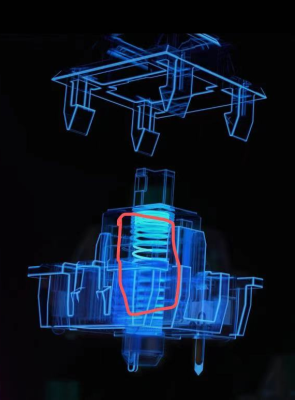
Marsback found me through my personal website and contacted me directly to gauge my interest in this keyboard. I’ll admit that I wasn’t too excited about it until I scrolled further in the email and saw that they are producing their own switches in-house.
I think that’s a really interesting choice given that Cherry MX and other switches exist, and there so many Cherry MX clones out there already. Naturally, I had to investigate, so following a short review, I’ll take it apart.
While I was waiting for the keyboard to arrive, I emailed my contact at Marsback to ask why they decided to go this route. They believe that the switches are the most important part of any mechanical keyboard (I wholeheartedly agree), and sought to control the keystrokes and the sound of the bounce. Fair enough.
I had also noticed that the switches are “double-lubricated”. I wondered if this meant that they did it in two places, or used grease and liquid, or what, and I was told that they lubricate the slider and both ends of the spring where it contacts the underside of the slider and the base of the switch.
First Impressions — This Is a Solid Keeb
When I first opened the box, the keeb started to glow like the briefcase in Pulp Fiction because the battery still had a charge. That’s a neat trick. I soon realized that there is no switch anywhere, so I guess it’s just on all the time. In fact, the only interruption in the translucent opaline polycarbonate body is the USB-C port. According to Marsback, each base is milled from a solid block of polycarbonate. Indeed, this keyboard looks like it’s carved from a big block of ice and belongs in the Fortress of Solitude. There aren’t even any case screws showing — all six of those are hidden beneath the key caps.
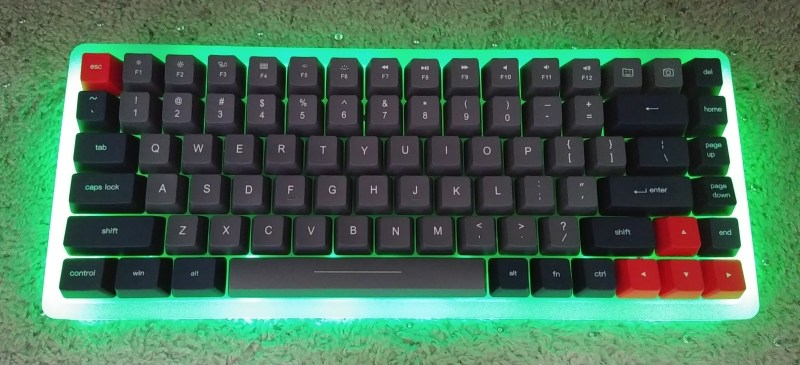
Let’s Talk About Those Key Caps
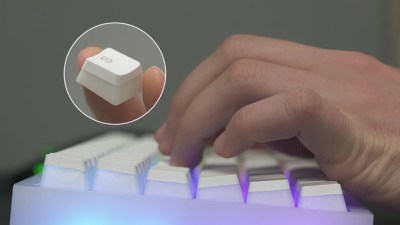
Speaking of the key caps, I don’t like them much as much as I hoped I would. I wanted the white ones, but convinced myself that they would just get dirty, so I opted for the dark-themed version instead. I later realized that the dark version has double-shot ABS key caps, and the white and sakura pink versions have PBT key caps. This could be just because I’ve got a prototype, and the real-deal dark theme caps will be PBT, but I don’t know.
I am not anti-ABS in general, but these particular keycaps just feel chalky to me. And the worst part is, they’re already starting to shine just a little bit. If I were going to use this keyboard with any regularity (and I honestly might, because it’s a good rectangle) I would probably just get new keycaps. They’re easy enough to swap out, and I don’t think I would have trouble finding a set that would fit, because there’s nothing super weird about the layout.
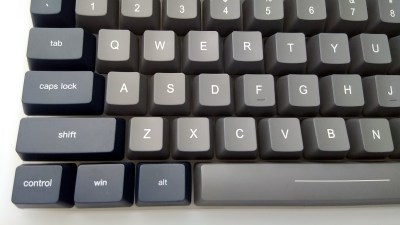 I offered money to Marsback for a set of the white pudding ‘caps, and they have kindly agreed to send me some. I’m totally pumped to get them because now that I’ve used this keyboard and seen the video, I’ve decided that the white puddings are the ideal choice to round out this little rainbow ice block.
I offered money to Marsback for a set of the white pudding ‘caps, and they have kindly agreed to send me some. I’m totally pumped to get them because now that I’ve used this keyboard and seen the video, I’ve decided that the white puddings are the ideal choice to round out this little rainbow ice block.
I have just one more complaint about the keycaps, and that is the font on the alpha keys: it’s just kind of meh looking. I dig the font on everything else, but these majuscules feel uninspired to me. There are no other capital letters on the board to compare them to, but it really feels like there are two different fonts going on here, and they don’t quite visually agree.
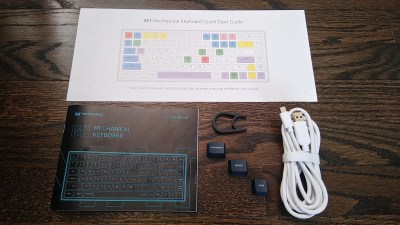 Getting the Lay of the Land
Getting the Lay of the Land
The layout itself is pretty good. I can honestly say that the 84 keys are sufficient, and there isn’t anything I miss. Control is where it should be in the lower left corner. I like the colorway, though I might have made Delete red as well. I still haven’t decided if I like the line on the space bar. I like that the top two rows are ortholinear, and the fact that Page Up and Page Down are profiled a little differently to help distinguish them from the alphas and arrows.
As someone who is now used to hitting Backspace with their left thumb, the Backspace of this keyboard is right where it oughta be, meaning that as I test out this rectangle, my ancient muscle memory has been hitting the key just fine without looking. Only a few times have I hit the Home key by mistake, during one of those zealous repeated Backspacings where you just keep messing up the word and and wildly pound the keyboard in disbelief.
This thing feels quite sturdy, which is always a plus. Between the weight and the rubber feet on the bottom, it’s not going to move around on the desk, but it’s not so heavy that you wouldn’t pack it up and take it with you if you decided to get some work done at the coffeehouse. The angle can’t be adjusted, but the default angle feels good to me. One really good thing I’ve noticed is that inspires good typing posture. I find myself floating my hands above it, which is kind of unusual for me — maybe I’m just too used to resting my palms on the Kinesis pads.
Let’s Get to Clackin’
So, how does it keeb? I must say that I really like this keyboard in spite of the key caps and the linear switches, and those are big obstacles to overcome. These are probably the greatest linear switches I’ve ever clacked on, which is saying a whole lot, because I really don’t like linear switches at all (but I know that plenty of gamers love them). I would be willing to bet that the nice thocky typing experience is due to the thick polycarbonate case and switch plate. The overall typing experience is really nice despite the lack of tactility in the switches. And although I’m used to a split keyboard, I don’t feel like this one is cramped.
Even though I try not to do it, I usually bottom out when I type, so this keyboard is especially noisy under my fingers. And it sounds fantastic! The backspace sounds different from every other switch, especially the space bar. To me, the backspace sounds like a woodpecker. Maybe it’s because of the stabilizer or the thickness of the wire. Have a listen:
Switch Teardown
I find it interesting that Marsback went to the trouble of making their own switches, but didn’t brand them and instead left them blank. The switches I took apart definitely felt as though their springs were lubed, but not overly so. It doesn’t feel heavy at all, so I think they must have used spray or liquid lube instead of grease.
One thing I did notice was the amount of plastic flashing left on some of the sliders. While it’s not a huge deal, if there’s a big enough flap of flash left on a slider’s shoulder, you might be able to feel it. Or a bit of flash on the stem might affect how your keycap fits or sits. But I think it’s likely that Marsback used factory second key switches for their media samples and will be more selective about the switches that make it into the hands of Kickstarter backers.
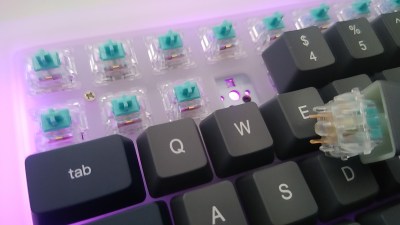 Keyboard Teardown
Keyboard Teardown
I felt a little weird tearing this keyboard down while it glowed happily at me. But it’s impossible to turn it off, and that huge battery is nowhere near dead, so I just turned off Bluetooth on my PC and enjoyed watching the pretty colors until it feel asleep.
This keyboard is really easy to take apart, which will make it easy to give it a nice, deep cleaning once in a while. All you have to do to see the other side of the board is pull the keycaps and untwist the six tiny Phillips-head screws. The switches are hot-swappable and sit in Kailh sockets, and you can leave those in place. There’s no need to take out the stabilizers — they will move with the PCB, which is screwed to the switch plate — another thick chunk of milky-white polycarbonate.
There are three chips on this board — the STM32 controller, the Nordic 52810 Bluetooth chip, and a third chip that I believe is a MOSFET driver for the LEDs. The STM32F411 is the same chip as the black pill microcontroller.
In Summary
Overall, I think this is a good keyboard, particularly because of the stay-put slab of a case. Normally I would shy away from spending so much on a keeb unless there’s a tactile or clicky switch option, but I was pleasantly surprised to find the best linear switches I’ve ever clacked on, and I credit the case for the solid, thocky feel that is reminiscent of really old keyboards. Even so, it’s quite nice that the switches are hot-swappable. That is one direction in which more manufacturers should head.

That said, now that I’ve played with one, I would gladly fork over $150 or so for everything but the switches and maybe the key caps. I’d like to see Marsback sell these as kits, especially since they are manufacturing not one but three types of linear switches with different required actuating forces. My prototype has the lightest type, MBS-I.
I do wish the LEDs around the perimeter were more densely packed. It’s not that the keeb needs to glow any brighter, but you can count the individual LEDs as it is now.
I wouldn’t worry about whether Marsback will deliver on the Kickstarter. The keyboard is already in early production, and this is not their first successful launch — that would be the Zephyr mouse with the fan. If you need more portable RGB in your life, this may very well be the party keeb for you.

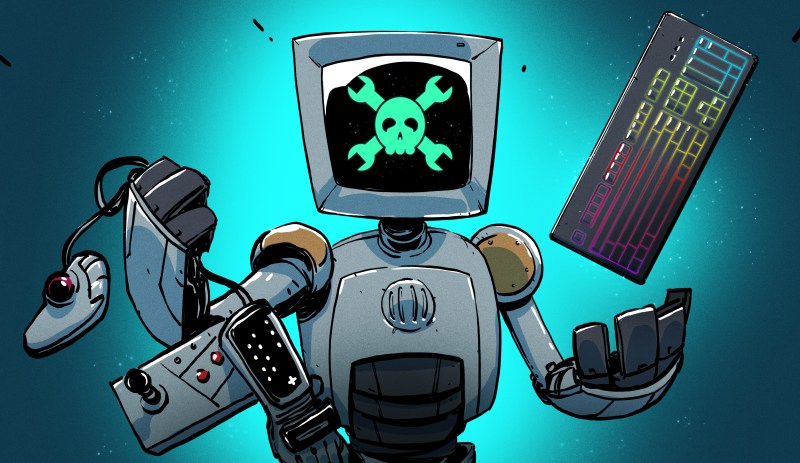
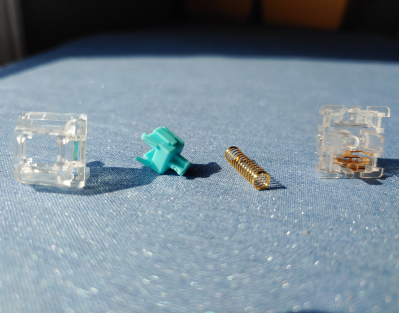
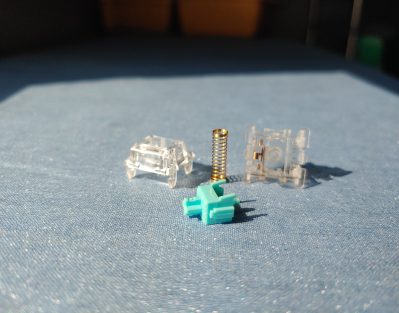
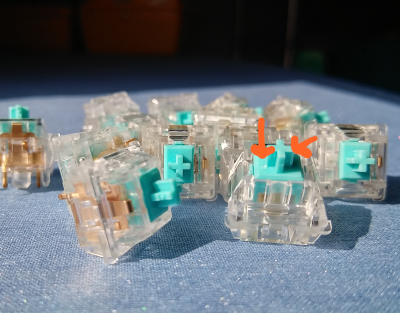
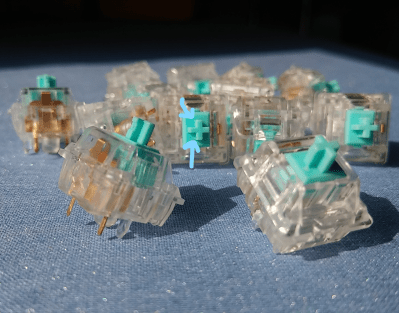
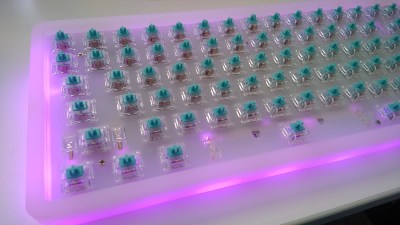
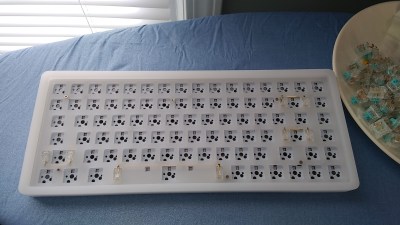
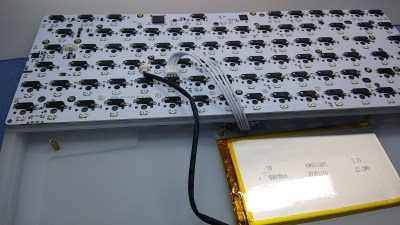
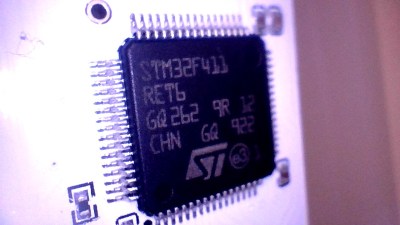
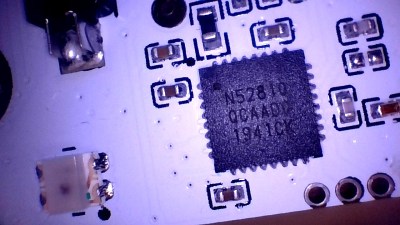
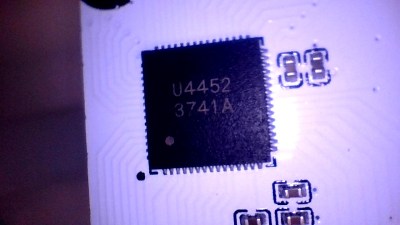














Is PBT more durable? No letters wearing off?
How much the legends wear and what kind of plastic are mostly unrelated.
PBT plastic itself is more wear-resistant and more rigid. Some keyboard nuts prefer it since it’s ‘clackier’ than ABS.
ABS is softer, so old keyboards where the texture is worn smooth are likely ABS. However, ABS is less brittle and tends to stand up better over time to abuse, and from what I understand is easier to mold doubleshots with.
As for wearing off the letters, that’s more dependent on the method used. Pad or inkjet printing is the cheapest and most likely to wear with use regardless of material. This is what most default PC keyboards come with. Dye-sub is similar to pad printing, but causes the ink to penetrate the surface so it survives wear better, but it’s more costly. Laser etching works well for dark or painted opaque-on-clear caps used with LED illumination.
Doubleshot keys are by far the best for longevity, and has been used on high quality keyboards for decades. Doubleshot forms the legends first in one or more colors, then molds them in with the key body and stem in a final molding. The legends extend all the way through the top surface, so they’ll be visible no matter how much the key wears.
Though, I don’t know if it’s particularly consistent when there is the same legend marking and keycap material on all keys. Sherlock Holmes would look at my keyboard and say it was owned by someone who mostly typed in Polish or something, because the keycap wear is inconsistent with English letter frequency. I particularly can’t figure out why the C looks far more worn than the T.
If you have a standard staggered keyboard and you are touch typing, it is likely that your middle finger is hitting c key at an angle which causes more wear on it compared to its neighbors. Just a guess.
For most of us, we probably type mostly in c or JavaScript or something rather than English.
If you are typing in code more than your native language (or English being the near standard international computing language) just for the comments I really don’t want to read your code…
A single sentence probably contains more of the letter characters than the function its describing – partly as programming tends to use weird pronunciation characters and numbers much more, but also because most of use will use copy and paste, autocomplete etc so we are not typing the wordier variable names etc fully anyway..
But who doesn’t then end up typing in normal(ish) language a great deal to search the api they have to interface with etc or browse these wonderful procrastination devices call websites when you need to take a break…
So the “c” is worn from using CTRL-C :-)
On my keyboard the “N” isthe most worn key, the printing on it already partially worn off.
Early HP calculators were known for doubleshot keys.
STM32 is nice, but I’m not a fan of proprietary firmwares and host tools when there are so many good options out there.
Ideally they’d ditch the two-MCU combo for a single nRF52840. Lower power, cheaper, and less complicated.
Yeah I was surprised to see a two chip solution too, though maybe they need the extra speed for some lighting or something? The f411 can be clocked way higher than the nrf52840 which tops out at 64mhz iirc.
You know there was time when keyboards just had an 8048 CPU with a few MHz? And my first PC – a 80486 had about half the clock speed (33MHz).
I think it’s more like the early days when people combined an ESP8266 with an extra Atmega. They did not really know how to bring their Arduino code on the ESP.
It’s probably using a version of QMK with the labels sanded off. Due to some monumentally obtuse licensing boilerplate in the nordic sdk, the QMK devs decided it was too big a risk to maintain an official port to them. So bluetooth tends to be implemented by putting QMK on an officially supported chip and running a fairly dumb bluetooth keyboard bridge firmware on the Nordic chip.
It seems a little strange to me, that keyboards are so expensive, you can throw in another microcontroller and associated circuitry without impacting the margin. But really, $200 for a 75% keyboard???? Yikes.
The microcontroller is easily the least expensive part on even a half decent mechanical keyboard.
Yeah, that’s kind of exactly what I just said.
Oh great another cherry mx clone with no bezel. Is there a hardware switch to disable the bluetooth?
Given that there’s no power switch, I wouldn’t hold out hope for that.
I wish. The best you can do is never pair it and always use the cable. But you will still wear down the battery if it’s in your bag and your bag hits spacebar and wakes it up.
I bet that last IC is an IS31FL3741A 39×9 LED driver.
The Word of the Day is: “Majuscule”
https://www.thefreedictionary.com/majuscule
n.
A large letter, either capital or uncial, used in writing or printing.
[French, from Latin māiusculus, somewhat larger, diminutive of māior, greater; see meg- in Indo-European roots.]
ma·jus′cule, ma·jus′cu·lar (mə-jŭs′kyə-lər) adj.
I thought the word of the day was “colorway”.
Europe is like spending a night with Van Darkholme. At first it looks exciting but all the charm is gone once you’re in a rack and he brings chili-flavoured lube and a glove that goes all the way up to his armpit. Then you realize that in his dungeon (the EU) you’re just a boy next door.
Did you confuse two tabs?
LOL!
The tab of acid with the tab of…?
Ah. A Firefox tab or a Madhatter tab. I can see making that mistake.
That’s oddly specific.
The capital letters on the QWERTY keys somehow remind me of those on really old typewriters.
I’m confused by “backspace with left thumb”. Hand crossover, or is backspace relocated on percentage keyboards?
If you look back through the “Inputs of Interest” series you’d see that Kristina is using a split keyboard with thumb clusters for her daily keyboard. I suppose it’s not obvious without some back story, or knowledge that split keyboards with thumb clusters even exist.
I use a Kinesis Advantage. I probably should have linked to that Kinesis post, but I feel like I already beat people over the head with that one and my compression sleeves post as often as I mention them in this column. I must remember the 10,000. https://xkcd.com/1053/
So is the answer that there is a backspace located near your left thumb on your keyboard? Still not clear.
That’s right, you can see the layout for a Kinesis Advantage here: https://kinesis-ergo.com/keyboards/advantage2-keyboard/#layout
I use a similar base layout on my Ergodox and find it very functional. I recommend anyone who spends a lot of their time typing and who can already touch type to try an ortholinear split keyboard without delay. You might be less productive for a couple of days, but your fingers and arms will thank you, and if you get a programmable keyboard you’ll end up more productive in the long run.
Looking at the video in the Kickstarter, the Sakura keycaps look like someone splattered strawberry jam on their keyboard. Or something worse. Like maybe they went to type something after slicing up their fingers with razor blades. Sorry.
Texting 911?
B^)
Oh. EEk. It just gets worse. That is just too exactly right.
Yeah, they are disappointing.
to small keyboard
So there is no way to turn off the keyboard other than letting the battery empty itself ?
That sounds like a waste …